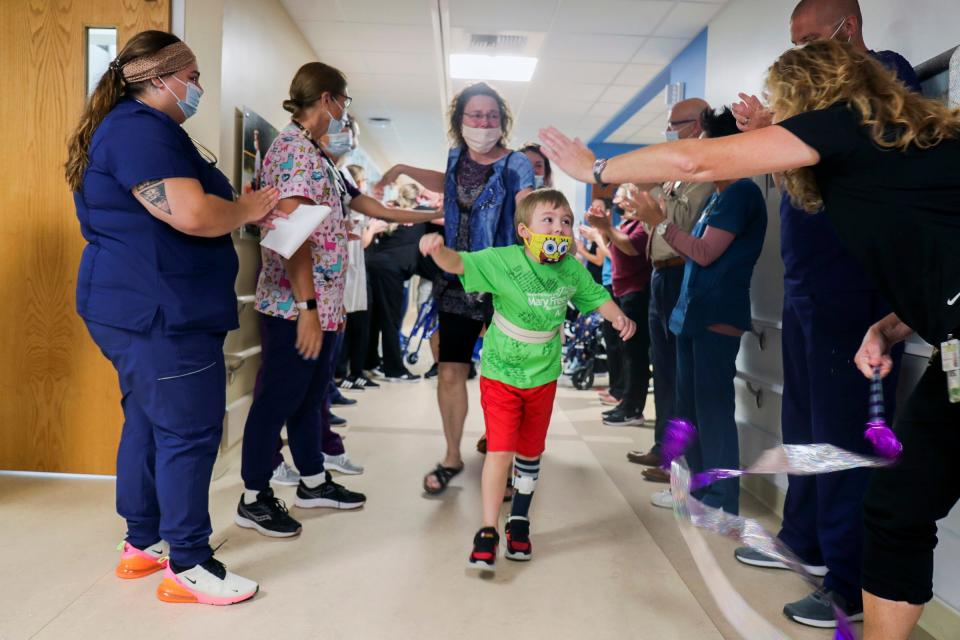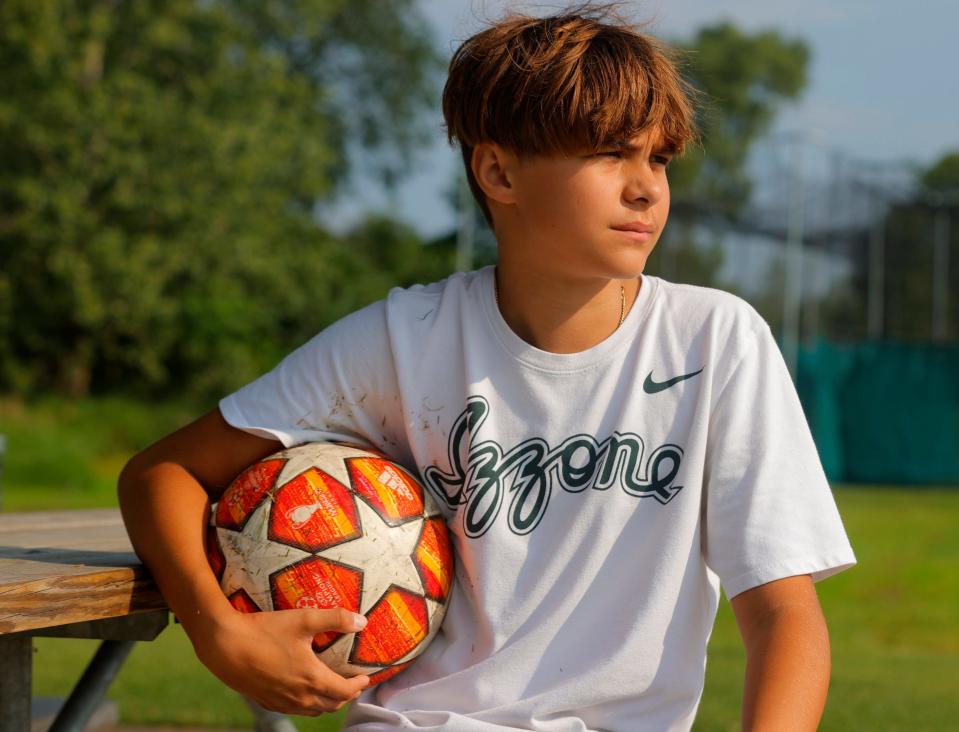Most kids who suffer crippling long COVID symptoms get better. Doctors worry about those who don’t.
Thirteen-year-old Rose Lehane Tureen’s debilitating headache has lasted a year and a half.
At 5 months old, Madelynn Birchmeier stopped reaching developmental milestones. She couldn’t hold a bottle and didn’t have the strength to crawl or sit up on her own. Now a year old, she’s undergoing therapy with hopes she’ll catch up.
For 7-year-old Waylon Wehrle, complications from COVID-19 stole his memory along with his ability to walk and talk. After months in hospitals and rehab, he has slowly improved but will have diabetes the rest of his life.
The virus heightened 14-year-old Nicaja Taylor’s anxiety and asthma and also may have triggered diabetes.
Thirteen-year-old Matthew Burris wasn’t very sick at first, but weeks after his infection he couldn’t run as hard or as fast. One day in the spring, he collapsed on a soccer field, unable to get enough air.
They are just a few of the children in the U.S. suffering long-term complications from COVID-19.
Changed by COVID: Young athletes who get COVID-19 have to play it safe

Recovery for most kids infected with the virus is swift and the illness is mild. But about 2% to 3%, Centers for Disease Control and Prevention Director Dr. Rochelle Walensky estimated, struggle with an array of puzzling and sometimes crippling symptoms that stretch on for weeks or months with no explanation and no clear end date.
Stay connected: Subscribe to Coronavirus Watch, your daily update on all things COVID-19 in the USA.
Clinics are popping up around the country to provide care for these children, and researchers are studying how the SARS-CoV-2 virus that causes COVID-19 triggered their lingering symptoms and how best to treat them. So far, the answers are few and the list of questions long.
CHANGED BY COVID
Day two of a weeklong USA TODAY Network series exploring long-haul COVID-19, the people who’ve suffered and the experts trying to help them. If you don’t want to miss future stories in this series, sign up for our COVID-19 newsletter here.
“Everyone wants quick answers,” said Daniel Munblit, an expert in the pediatric immune system at Imperial College London researching long-haul COVID-19. “We do not have answers.”
In a study he helped lead in Russia, researchers found a quarter of children hospitalized for COVID-19 continued to have symptoms six to eight months after they were sent home.
Still, most of the children – even the sickest – recovered.
“We should not exaggerate the problem,” Munblit said, but “at the same time, we should not downplay and say that none are getting it.”
More research is needed to better understand the condition, he said.
“We’re talking about potential consequences that may affect these children for decades. Even if it’s a tiny proportion of children, it’s very much worth investigating.”
Two percent may seem like a small number, said Dr. Sean O’Leary, a pediatric infectious disease specialist at Children’s Hospital Colorado. But with about 5 million children in the U.S. infected so far that's about 100,000. “Do the math," he said. "That’s a lot of kids, right?”
And the share of children in the U.S. getting sick and hospitalized with the virus is climbing as schools reopen and kids return to classrooms largely unvaccinated. The Pfizer-BioNTECH COVID-19 vaccine has an emergency use authorization for adolescents ages 12-15 and is fully authorized for people 16 and older. But younger children still aren’t eligible, leaving them vulnerable to the extremely contagious delta variant.
“If you’re not vaccinated, in a lot of parts of the country, there’s a very reasonable chance you’re going to get this sometime in the coming weeks or months,” said O’Leary, who also is a liaison to the CDC’s vaccine advisory committee. “Roughly half of 12- to 17-year-olds are vaccinated at this point, and then there are all the younger kids who can’t get vaccines.”

Is MIS-C a long-haul COVID symptom?
An even smaller subset of children end up with a rare complication known as multisystem inflammatory syndrome – children, or MIS-C. The extreme immune reaction to COVID-19 results in fever and severe inflammation in multiple organs that can include the heart, brain, lungs, kidneys, eyes, blood vessels, lungs, skin and digestive system. It most commonly appears several weeks after the initial coronavirus infection and can lead to hospitalization, organ failure, and, in rare instances, death.
Since the pandemic began, the CDC has identified 4,661 cases of MIS-C nationally and 41 deaths from the condition. It has disproportionately affected children who are Black or Hispanic/Latino – the same populations who have carried a heavier burden of COVID-19 overall, and is more likely to strike boys than girls.
Dr. Clifford Bogue, the chair of pediatrics and chief medical officer at Yale New Haven Children's Hospital, in Connecticut, has treated several dozen children with MIS-C.
Of the 120 children hospitalized at the clinic so far, about half came in for a different complaint and then tested positive. The other half sought care for COVID-19, and half of those had MIS-C.
“The good news is all the children have survived and done reasonably well,” he said.
So far, Bogue said, he and his colleagues aren’t seeing long-term complications in kids with MIS-C, though it hasn’t been long enough to know for certain.
MIS-C is still so new, it can be hard for doctors to recognize. In mid-summer, a child was transferred to Yale New Haven for a suspected case, but it ended up being appendicitis, said Dr. Elijah Paintsil, a pediatric infectious disease expert there.
Some kids bounce right back after a few days in the hospital, treated perhaps with steroids to tamp down inflammation, immunoglobulin to boost the immune response to infection and supportive care like fluids. But Paintsil said children who have endured intensive care often have long-term mental health issues, like nightmares.
Much about COVID-19 in kids remains a mystery.
“It’s a new phenomenon. That’s why we’re taking it seriously,” Paintsil said. His clinic plans to follow up with MIS-C patients at 2, 6, 9 months and a year after their initial treatment to track their recovery.
His team has learned to “admit to the parents that we don’t know what we are doing, but hey, stay with us, let’s do this together,” he said.
Dr. Laura Malone, a pediatric neurologist at the Pediatric Post COVID-19 Rehabilitation Clinic at the Kennedy Krieger Institute in Baltimore, said there’s no definitive link between any particular demographic or preexisting medical condition that might make one child more likely than another to develop long-haul COVID symptoms.
“In some of the patients that we’ve seen, these are relatively healthy children that don’t have a lot of pre-existing medical conditions that continue to have persistent symptoms,” she said.
Malone said MIS-C should fall beneath the long-haul COVID umbrella – as a type of long-lasting after-effect from the virus; other doctors disagree. Even what qualifies as a long-haul symptom hasn’t been formally defined.
“The definitions of what long COVID is continues to evolve,” Malone said. “But most people refer to any post-acute syndrome of COVID as symptoms lasting more than four weeks. And that does include children and adults that have been hospitalized, so that would include the MIS-C patients as well.”

How wide-ranging are kids' symptoms?
The medical problems kids with long-haul COVID are experiencing seem to mirror what many adults have reported, said Malone, an assistant professor of neurology and physical medicine and rehabilitation at the Johns Hopkins University School of Medicine.
The complaints are wide-ranging and can include fatigue, headaches, dizziness, chest pain, shortness of breath, sleep disturbances, decreased endurance or poor conditioning, pain, rashes, loss of smell or distorted smells. Some children have lingering rapid heartbeat.
Mood and attention issues can make it challenging to concentrate or do schoolwork, Malone said, and some kids might not be able to explain how they're feeling.
“They might have declining grades in school but they may not be able to say, ‘I’m having difficulty thinking or concentrating or paying attention,’” she said.
Dr. Alicia Johnston, who leads the post-COVID clinic at Boston Children’s Hospital, said she’s had patients who had to drop out of their freshman year of college or miss a semester of high school. She’s seen competitive athletes too exhausted to get out of bed, and children complaining about chronic pain.
“It’s life-altering on a number of different levels,” she said. “These kids have physical, social and psychological consequences of post-COVID syndrome.”
Sometimes symptoms fade and then return. Or they don’t show up until a few months after an infection, when the children “hit the wall,” she said.
“That seems pretty far out to be calling it post-COVID but I don’t think we know. We’ve seen a number of kids with that scenario,” Johnston said. “Early on we would have said, ‘Well that’s clearly not COVID,’ but I’m not so sure about that now … it’s all so new.”
The symptoms are fairly similar to those seen with other post-viral infections, like the Epstein-Barr virus that causes mononucleosis, she said.
That makes her optimistic about their prognosis, though she can’t do much for the long-haul COVID kids now other than treat their symptoms, manage their pain and validate their experiences.
“It’s a painful, long process, but kids can recover,” Johnston said.
When will long-haul COVID in kids end?
How long it will take is impossible to predict. At Children’s Hospital of Philadelphia, pediatric infectious disease specialist Dr. Sanjeev Swami also uses Epstein-Barr infections as his model for treating long-haul COVID.
There’s no good medication to speed recovery from mono, he said, just “resetting physiology” by focusing on getting good sleep, and slowly boosting exercise. “It’s interventions,” Swami said, “but it’s not ‘Here’s a prescription, go to your pharmacy, take a pill for a week,’ which would be much easier but unfortunately doesn’t actually help.”
He now has long-haul COVID patients who’ve been sick for eight to 12 months and has to reset their expectations that recovery will come quickly.
Week by week, though, Swami expects to see them slowly improve. Generally, a child who has been sick for two months will take about the same amount of time to recover.
“You’re going to have good and bad days,” he said. “You can’t think about it with such a short time frame.”
Dr. Marc Hershenson, a pediatric pulmonologist at the University of Michigan’s Pediatric Post-COVID Syndrome Clinic, said he and other doctors are concerned about how quickly the virus is spreading now among kids who’ve largely returned to in-person learning at schools around the country.
“We’re worried,” he said. “We’re worried that there’s going to be more acute pneumonia with COVID in the tweens and teens that we haven’t seen before. And then we’re worried about the MIS-C. And then we’re worried about the long-term effects on the lung, in terms of flare ups of asthma or development of asthma in kids who may have had a tendency in the past but maybe hadn’t had full-blown asthma.
“I hope I’m wrong about all this and that, you know, somehow we’ll dodge a bullet, but it doesn't look well.”

This article originally appeared on USA TODAY: Long COVID in kids: Lasting illnesses are puzzling, can be crippling

 Yahoo Movies
Yahoo Movies 
